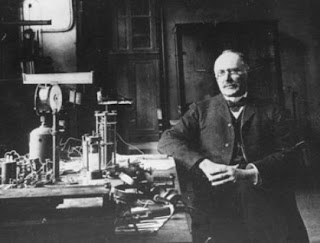Michael Faraday [1791-1867], an English chemist and
physicist who, in 1831, converted magnetism into electricity. By varying
magnetic forces, Faraday was able to generate electrical currents in a wire -
known today as electro-magnetic induction. This phenomenon is taken for
granted today but was considered as "magic" in his day as there was
no such thing as electricity, only DC current was available generated by voltaic
cells.
When 13 years old, he worked for a bookseller and soon became a book apprentice. This work exposed him to science and resulted in his interest in chemistry and simple electricity. Faraday was a ‘deep’ thinker, a great questioner, and an imaginative person.
When 13 years old, he worked for a bookseller and soon became a book apprentice. This work exposed him to science and resulted in his interest in chemistry and simple electricity. Faraday was a ‘deep’ thinker, a great questioner, and an imaginative person.
In 1812, he became
a student of Sir Humphry Davy, who was a lecturer at the Royal Academy, where Faraday
was a ‘bookman’ for him [took notes then bounded Davy’s lectures]. Faraday
soon went to work for the Academy assisting lecturers by maintaining their
electrical equipment. As time progressed and his science knowledge increased,
he also became a sought after lecturer and began devoting time to research and
experimentation. While with Humphry, he was interested in Ampere’s work [first
to measure electrical current] and eventually picked up where Ampere left
off. Since electricity produced
magnetism, Faraday set out to see if magnetism would produce electricity. He was successful and published several
papers and lectured regarding magnetism generating electricity.
Faraday lived in a
time where other scientists were suspicious of other scientist, and he was
suspected of taking credit of research conducted by others. Faraday was not
University educated but a self-educated man.
As of a result, his educated contemporaries were suspicious, jealous and
resented his standing in the scientific world.
Faraday was a
humble, over sensitive person and decided to record his views on
electromagnetism. He wrote his views in a sealed document to show future
scientist the validity of his discoveries but especially his theories.
In 1832, he
submitted a sealed document to the Royal Society. The Society deposited the
document in a locked strong box where it remained secured and unopened for over
100 years! In 1937, the Royal Society
opened the box and examined Faraday’s handwritten notes where he predicted
the existence of electromagnetic waves.
Faraday inventing
radio technology is certainly a giant leap of the imagination but it does show
his strong skills as an experimenter and his understanding of electromagnetic
wave field theory [relationship between light and electricity, that space was
filled with electric/magnetic lines-of-force]. Thus, one can easily say that
Faraday ushered in the "radio era" !
Faraday’s Sealed
Letter:
Royal Institution
March 12, 1832
Certain of the results of the
investigations which are embodied in the two papers entitled ‘Experimental
Researches in Electricity’ lately read to the Royal Society, and the views
arising therefrom, in connexion with other views and experiments lead me to
believe that magnetic action is progressive, and requires time, i.e. that when
a magnet acts upon a distant magnet or piece of iron, the influencing cause
(which I may for the moment call magnetism) proceeds gradually from the
magnetic bodies, and requires time for its transmission, which will probably be
found to be very sensible.
I think also, that I see
reason for supposing that electric induction (of tension) is also performed in
a similar progressive way.
I am inclined to compare the
diffusion of magnetic forces from a magnetic pole to the vibrations upon the
surface of disturbed water, or those of air in the phenomenon of sound; i.e. I
am inclined to think the vibratory theory will apply to these phenomena as it
does to sound, and most probably to light.
By analogy, I think it may
possibly apply to the phenomenon of induction of electricity of tension also.
These views I wish to work out
experimentally; but as much of my time is engaged in the duties of my office,
and as the experiments will therefore be prolonged, and may in their course be
subject to the observation of others, I wish, by depositing this paper in the
care of the Royal Society, to take possession as it were of a certain date; and
so have right, if they are confirmed by experiment, to claim credit for the
views at that date; at which time as far as I know, no one is conscious of or
can claim them but myself.
M. Faraday





